Atropa belladonna
| Atropa belladonna | |
|---|---|
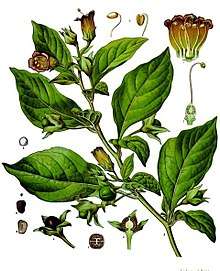 | |
| Illustration from Köhler's Medicinal Plants 1887 | |
| Scientific classification | |
| Kingdom: | Plantae |
| Clade: | Angiosperms |
| Clade: | Eudicots |
| Clade: | Asterids |
| Order: | Solanales |
| Family: | Solanaceae |
| Genus: | Atropa |
| Species: | A. belladonna |
| Binomial name | |
| Atropa belladonna | |
Atropa belladonna, commonly known as belladonna or deadly nightshade, is a perennial herbaceous plant in the nightshade family Solanaceae, which includes tomatoes, potatoes, and eggplant (aubergine). It is native to Europe, North Africa, and Western Asia. Its distribution extends from Great Britain in the west to western Ukraine and the Iranian province of Gilan in the east. It is also naturalised and/or introduced in some parts of Canada and the United States.
The foliage and berries are extremely toxic when ingested, containing tropane alkaloids.[1][2] These toxins include atropine, scopolamine and hyoscyamine, which cause delirium and hallucinations,[1][2][3] and are also used as pharmaceutical anticholinergics.
Atropa belladonna has unpredictable effects.[1] The antidote for belladonna poisoning is physostigmine or pilocarpine, the same as for atropine.[4]
It has a long history of use as a medicine, cosmetic, and poison.[1][2] Before the Middle Ages, it was used as an anesthetic for surgery; the ancient Romans used it as a poison (the wife of Emperor Augustus and the wife of Claudius both were rumored to have used it for murder); and, predating this, it was used to make poison-tipped arrows. The genus name Atropa comes from Atropos ("unable to be turned aside"), one of the three Fates in Greek mythology, who cut the thread of life after her sisters had spun and measured it; and the name "bella donna" is derived from Italian and means "beautiful woman" because the herb was used in eye-drops by women to dilate the pupils of the eyes to make them appear seductive.[2][5][6]
Description
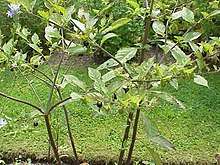
Atropa belladonna is a branching herbaceous perennial rhizomatous hemicryptophyte, often growing as a subshrub from a fleshy rootstock. Plants grow to 2 m (6.6 ft) tall with ovate leaves 18 cm (7.1 in) long. The bell-shaped flowers are dull purple with green tinges and faintly scented. The fruits are berries, which are green, ripening to a shiny-black, and approximately 1.5 cm (0.59 in) in diameter. The berries are sweet and are consumed by animals that disperse the seeds in their droppings, even though they contain toxic alkaloids. (See Toxicity)[7] There is a pale-yellow flowering form called Atropa belladonna var. lutea with pale yellow fruit.
Distribution
Atropa belladonna is native to temperate southern, Central and Eastern Europe; North Africa, Turkey, Iran and the Caucasus, but has been cultivated and introduced outside its native range. In southern Sweden it was recorded in Flora of Skåne in 1870 as grown in apothecary gardens near Malmö.[8]
In Britain it is native only on calcareous soils, on disturbed ground, field margins, hedgerows and open woodland. More widespread as an alien, it is often a relic of cultivation as a medicinal herb. Seed is spread mainly by birds.[9]
It is naturalized in parts of North America, where it is often found in shady, moist locations with limestone-rich soils. It is considered a weed species in parts of the world,[10] where it colonizes areas with disturbed soils.[11]
Cultivation
Atropa belladonna is rarely used in gardens, but, when grown, it is usually for its large upright habit and showy berries.[12] Germination of the small seeds is often difficult, due to hard seed coats that cause seed dormancy. Germination takes several weeks under alternating temperature conditions, but can be sped up with the use of gibberellic acid.[13] The seedlings need sterile soil to prevent damping off and resent root disturbance during transplanting.
Naming and taxonomy
The name Atropa belladonna was published by Linnaeus in Species Plantarum in 1753.[14] It is in the nightshade family (Solanaceae), which it shares with potatoes, tomatoes, eggplants, jimsonweed, tobacco, wolfberry, and chili peppers. The common names for this species include belladonna, deadly nightshade, divale, dwale,[15] banewort, devil's berries, naughty man's cherries, death cherries, beautiful death, devil's herb, great morel, and dwayberry.[16]
The name Atropa is derived from that of the Greek goddess Atropos - 'she who may not be turned aside' i.e. 'the implacable' - one of the three Greek fates or destinies who would determine the course of a man's life by the weaving of threads that symbolized his birth, the events in his life, and finally his death, with Atropos cutting these threads to mark the last of these.[17][18] The name "belladonna" comes from the Italian language, meaning "beautiful lady";[15] originating either from its usage as cosmetic for the face or, more probably, from its usage to increase the pupil size in women.[17][18]
Toxicity

Belladonna is one of the most toxic plants found in the Eastern Hemisphere,[19] and its use by mouth increases risk in numerous clinical conditions, such as complications of pregnancy, cardiovascular diseases, gastrointestinal disorders, and psychiatric disorders, among others.[1][2] All parts of the plant contain tropane alkaloids.[1][20] Roots have up to 1.3%, leaves 1.2%, stalks 0.65%, flowers 0.6%, ripe berries 0.7%, and seeds 0.4% tropane alkaloids; leaves reach maximal alkaloid content when the plant is budding and flowering, roots are most poisonous in the end of the plant’s vegetation period.[21] Belladonna nectar is transformed by bees into honey that also contains tropane alkaloids.[22] The berries pose the greatest danger to children because they look attractive and have a somewhat sweet taste.[16][23][24] The root of the plant is generally the most toxic part, though this can vary from one specimen to another.[16][20]
The active agents in belladonna, atropine, hyoscine (scopolamine), and hyoscyamine, have anticholinergic properties.[2][25] The symptoms of belladonna poisoning include dilated pupils, sensitivity to light, blurred vision, tachycardia, loss of balance, staggering, headache, rash, flushing, severely dry mouth and throat, slurred speech, urinary retention, constipation, confusion, hallucinations, delirium, and convulsions.[2][26][27] In 2009, A. belladonna berries were mistaken for blueberries by an adult woman; the six berries she ate were documented to result in severe anticholinergic syndrome.[28] The plant's deadly symptoms are caused by atropine's disruption of the parasympathetic nervous system's ability to regulate involuntary activities, such as sweating, breathing, and heart rate. The antidote for belladonna poisoning is physostigmine or pilocarpine, the same as for atropine.[29]
Atropa belladonna is also toxic to many domestic animals, causing narcosis and paralysis.[30] However, cattle and rabbits eat the plant seemingly without suffering harmful effects.[27] In humans, its anticholinergic properties will cause the disruption of cognitive capacities, such as memory and learning.[25]
Legal status
Belladonna cultivation is legal in Southern and Eastern Europe, Pakistan, North America, and Brazil.[21] All parts of the belladonna plant can be cultivated, bought, kept, and distributed (sold, traded or given) without a legal license or medical prescription in the United States. Sales of belladonna in the United States conform to US supplement laws or are regulated by the FDA.[31] Belladonna leaves and roots can be bought with a medical prescription in pharmacies throughout Germany.[32]
Uses
Cosmetics
The common name belladonna originates from its historic use by women, as bella donna is Italian for "beautiful lady". Drops prepared from the belladonna plant were used to dilate women's pupils, an effect considered to be attractive and seductive.[5][6] Belladonna drops act as a muscarinic antagonist, blocking receptors in the muscles of the eye that constrict pupil size.[33] Belladonna is currently rarely used cosmetically, as it carries the adverse effects of causing minor visual distortions, inability to focus on near objects, and increased heart rate. Prolonged usage was reputed to cause blindness.[34]
Medicinal uses
Scientific evidence to recommend the use of A. belladonna in its natural form for any condition is insufficient,[1][2] although some of its components, in particular l-atropine, which was purified from belladonna in the 1830s, have accepted medical uses.[27] Donnatal is a prescription pharmaceutical, approved in the United States by the FDA, that combines natural belladonna alkaloids in a specific, fixed ratio with phenobarbital to provide peripheral anticholinergic/antispasmodic action and mild sedation. According to its labeling, it is possibly effective for use as adjunctive therapy in the treatment of irritable bowel syndrome (irritable colon, spastic colon, mucous colitis) and acute enterocolitis.[35]
Belladonna has been used in herbal medicine for centuries as a pain reliever, muscle relaxer, and anti-inflammatory, and to treat menstrual problems, peptic ulcer disease, histaminic reaction, and motion sickness.[1][2][36] At least one 19th-century eclectic medicine journal explained how to prepare a belladonna tincture for direct administration to patients.[37]
Belladonna tinctures, decoctions, and powders, as well as alkaloid salt mixtures, are still produced for pharmaceutical use, and these are often standardised at 1037 parts hyoscyamine to 194 parts atropine and 65 parts scopolamine. The alkaloids are compounded with phenobarbital and/or kaolin and pectin for use in various functional gastrointestinal disorders. The tincture, used for identical purposes, remains in most pharmacopoeias, with a similar tincture of Datura stramonium having been in the US Pharmacopoeia at least until the late 1930s. Cigarettes with belladonna leaves soaked in opium tincture were a prescription medicine as recently as 1930.[21] The combination of belladonna and opium, in powder, tincture, or alkaloid form, is particularly useful by mouth or as a suppository for diarrhoea and some forms of visceral pain; it can be made by a compounding pharmacist, and may be available as a manufactured fixed combination product in some countries (e.g., B&O Supprettes).
Scopolamine is used as the hydrobromide salt for gastrointestinal complaints and motion sickness, and to potentiate the analgesic and anxiolytic effects of opioid analgesics. It was formerly used in a painkiller called "twilight sleep" in childbirth.[38]
Atropine sulphate is used as a mydriatic and cycloplegic for eye examinations. It is also used as an antidote to organophosphate and carbamate poisoning, and is loaded in an autoinjector for use in case of a nerve gas attack. Atropinisation (administration of a sufficient dose to block nerve gas effects) results in 100 percent blockade of the muscarinic acetylcholine receptors, and atropine sulphate is the benchmark for measuring the power of anticholinergic drugs.
Hyoscyamine is used as the sulphate or hydrobromide for gastrointestinal problems and Parkinson's disease. Its side-effect profile is intermediate to those of atropine and scopolamine, and can also be used to combat the toxic effects of organophosphates. Hyoscyamine was the primary alkaloid in Asthmador, a nonpresciption treatment for the relief of bronchial asthma, until Asthmador was discontinued.
Alternative medicine and toxicity risk
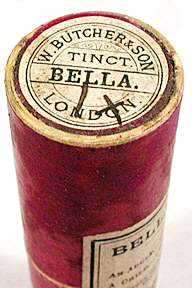
Belladonna preparations are used in homeopathy as alternative medicine treatments for various conditions.[1][39][40] In homeopathic practices, belladonna was prescribed by German physician Samuel Hahnemann as a topical medication for inflammation and pain.[1] In the form of Doktor Koster's Antigaspills, belladonna was a homeopathic medication for upset stomach and excessive flatulence.[41] In one study, the most common preparation was adulterated by dilution to a level not containing any belladonna.[40] There is insufficient scientific evidence justifying the use of belladonna for these or any other clinical disorders.[1]
In 2010 and 2016, the US Food and Drug Administration warned consumers against the use of homeopathic teething tablets and gels containing belladonna as used for infants and children, stating that the products may be toxic, causing "seizures, difficulty breathing, lethargy, excessive sleepiness, muscle weakness, skin flushing, constipation, difficulty urinating, or agitation".[42][43]
Recreational drug
Atropa belladonna and related plants, such as Datura stramonium (commonly known as jimson weed or jimsonweed), have occasionally been used as recreational drugs because of the vivid hallucinations and delirium they produce. However, these hallucinations are most commonly described as very unpleasant, and recreational use is considered extremely dangerous because of the high risk of unintentional fatal overdose.[44][45][46] In addition, the central nervous system effects of atropine include memory disruption, which may lead to severe confusion.[47] The major effects of belladonna consumption last for three to four hours, visual hallucinations can last for three to four days, and some negative aftereffects are preserved for several days.[21][48] The use of belladonna as a recreational drug is reported to bring about predominantly bad trips that the users want never to repeat for as long as they live.[48] Trips induced by belladonna are threatening, dark, demonic, hellish, frightening, and terrifying.[21] Occasionally, belladonna can induce out-of-body experiences,[49] a heightened sense of awareness,[50] and enhance sexual, mystical and lucid dreaming experiences often in combination with other psychoactive plants.[51][52] Positive experiences induced by belladonna consumption are rare.[21] Historically, the plant was an important, active ingredient in witches' flying ointments : complex, transdermally-absorbed hallucinogens with a fatty or oily base, which caused a deathlike trance in which vivid hallucinations of flight and bacchanalian carousal were experienced[53][see below].
Poison
The tropane alkaloids of A. belladonna were used as poisons, and early humans made poisonous arrows from the plant.[54] In Ancient Rome, it was used as a poison by Agrippina the Younger, wife of Emperor Claudius on the advice of Locusta, a woman who specialized in poisons, and Livia, who is rumored to have used it to kill her husband Emperor Augustus.[54][55]
Macbeth of Scotland, when he was still one of the lieutenants of King Duncan I of Scotland, used it during a truce to poison the troops of the invading Harold Harefoot, King of England, to the point that the English troops were unable to stand their ground and had to retreat to their ships.[18]
Medical historians also suspect that Solomon Northup, a free black man who was kidnapped and sold into slavery in 1841, was poisoned using a combination of Atropa belladonna and laudanum.[56]
Folklore
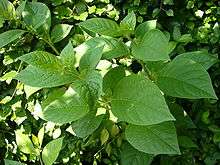
Flying ointment
In the past, witches were believed to use a mixture of belladonna, opium poppy and other plants, typically poisonous (such as monkshood and poison hemlock), in flying ointment, which they applied to help them fly to gatherings with other witches. Carlo Ginzburg and others have argued that flying ointments were preparations meant to encourage hallucinatory dreaming; a possible explanation for the inclusion of belladonna and opium poppy in flying ointments concerns the known antagonism between tropane alkaloids of belladonna (scopolamine) and opiate alkaloids in the opium poppy, Papaver somniferum (to be specific, morphine), which produces a dream-like waking state. This antagonism was known in folk medicine, discussed in traditional medicine formularies.[57][58] The belladonna herb was also notable for its unpredictable effects from toxicity.[59][60]
Female attractiveness
Among the ancient folk traditions of the Romanian (Moldavian) / Ukrainian region of Bukovina in the Carpathians is the ritual for a Bukovinian girl to enhance her attractiveness by making an offering to deadly nightshade. She entered the fields on a Sunday in Shrovetide, clad in her Sunday best, accompanied by her mother and bringing a bag of bread, salt, and brandy. She would dig up a deadly nightshade root and leave the three offerings in its place. As she returned home, she carried the root on the top of her head. On the way both to and from home, she avoided all quarrels and arguments. If asked by anyone on the way back what she was taking home, she would not divulge the truth or the spell would break.[61]
Etymology
Atropa means "inflexible" or "implacable", and is derived from the Greek Atropos, the name of one of the three Moirai. Belladonna is derived from Italian, meaning "beautiful lady". The juice of A. belladonna was applied as a decoction to beautify by inducing pallid skin and dilated eyes.[62]
Gallery
 Atropa belladonna L. Single flower in profile.
Atropa belladonna L. Single flower in profile.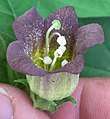 Atropa belladonna L. Single flower angled to show both exterior and interior.
Atropa belladonna L. Single flower angled to show both exterior and interior. Atropa belladonna L. Single flower, full face, showing reticulated corolla base and insertion of ( characteristically curled ) stamens, and pistil.
Atropa belladonna L. Single flower, full face, showing reticulated corolla base and insertion of ( characteristically curled ) stamens, and pistil. Atropa belladonna L. Reverse of fruiting calyx, showing concave backs of calyx lobes with dirt from air pollution coating sticky trichomes.
Atropa belladonna L. Reverse of fruiting calyx, showing concave backs of calyx lobes with dirt from air pollution coating sticky trichomes.
See also
References
- 1 2 3 4 5 6 7 8 9 10 11 Ulbricht, C; Basch, E; Hammerness, P; Vora, M; Wylie Jr, J; Woods, J (2004). "An evidence-based systematic review of belladonna by the natural standard research collaboration" (PDF). Journal of Herbal Pharmacotherapy. 4 (4): 61–90. PMID 15927926.
- 1 2 3 4 5 6 7 8 9 "Belladonna". MedlinePlus, US National Institutes of Health. 23 February 2015. Retrieved 17 October 2017.
- ↑ Kuhn, Cynthia; Swartzwelder, Scott; Wilson, Wilkie; Wilson, Leigh Heather; Foster, Jeremy (2008). Buzzed. The Straight Facts about the Most Used and Abused Drugs from Alcohol to Ecstasy. New York: W. W. Norton & Company. p. 107. ISBN 0-393-32985-2.
- ↑ Potter, Samuel O.L. (1893). A Handbook of Materia Medica Pharmacy and Therapeutics. London: P. Blakiston's. p. 53.
- 1 2 Hofmann, Albert; Schultes, Richard Evans (1987). Plants of the Gods: Origins of Hallucinogenic Use. New York: Van der Marck Editions. p. 88. ISBN 0-912383-37-2.
- 1 2 Tombs S, Silverman I (2004). "Pupillometry: A sexual selection approach". Evolution and Human Behavior. 25 (4): 211–228. doi:10.1016/j.evolhumbehav.2004.05.001.
- ↑ Kay QON (2008). Marshall, C.; Grace, J., eds. "Edible fruits in a cool climate: the evolution and ecology of endozoochory in the European flora". Fruit and Seed Production: Aspects of Development, Environmental Physiology and Ecology (Society for Experimental Biology Seminar Series). Cambridge, UK: Cambridge University Press: 240. ISBN 0-521-05045-6.
- ↑ Hylander, N. (1971). "Prima loca plantarum vascularium Sueciae. Första litteraturuppgift för Sveriges vildväxande kärlväxter jämte uppgifter om första svenska fynd. Förvildade eller i senare tid inkomna växter". Svensk Botanisk Tidskrift. 64: 332.
- ↑ "Online Atlas of the British and Irish Flora: Atropa belladonna (Deadly nightshade)". Botanical Society of Britain and Ireland (BSBI).
- ↑ "PLANTS Profile for Atropa bella-donna (belladonna) | USDA PLANTS". Retrieved 2008-07-08.
- ↑ Stepp JR (June 2004). "The role of weeds as sources of pharmaceuticals". J Ethnopharmacol. 92 (2–3): 163–6. doi:10.1016/j.jep.2004.03.002. PMID 15137997.
- ↑ Stuart, David (2004). Dangerous garden: the quest for plants to change our lives. Cambridge: Harvard University Press. p. 49. ISBN 0-674-01104-X.
- ↑ Genova E, Komitska G, Beeva Y (1997). "Study on the germination of Atropa Bella-donna L. seeds" (PDF). Bulgarian Journal of Plant Physiology. 23 (1–2): 61–66. Retrieved 2008-07-08.
- ↑ "Solanaceae Atropa belladonna L." Plant Name Details. IPNI. 2003-07-02. Retrieved 2008-03-01.
Solanaceae Atropa belladonna L. Species Plantarum 2 1753 "Habitat in Austriae, Angliae montibus sylvosis."
- 1 2 Spiegl, Fritz (1996). Fritz Spiegl's Sick Notes: An Alphabetical Browsing-Book of Derivatives, Abbreviations, Mnemonics and Slang for Amusement and Edification of Medics, Nurses, Patients and Hypochondriacs. Washington, DC: Taylor & Francis. pp. 21–22. ISBN 1-85070-627-1.
- 1 2 3 Grieve, Margaret; Leyel, C. F. (1971). Modern Herbal. Courier Dover Publications. p. 584. ISBN 0-486-22799-5. Retrieved 2008-07-08.
- 1 2 Edward Harris Ruddock (1867). The Homoeopathic Vade Mecum of Modern Medicine and Surgery: For the Use of Junior Practitioners, Students, Clergymen, Missionaries, Heads of Families, Etc (2 ed.). Jarrold and Sons. pp. 503–508.
- 1 2 3 R. Groombridge, ed. (1839). The Naturalist: Illustrative of the Animal, Vegetable, and Mineral Kingdoms. R. Groombridge. p. 193. Notes: v.4-5 (1838-1839)
- ↑ "Herbarium: Selection of species from European flora".
- 1 2 "Committee for Veterinary Medicinal Products, Atropa Belladonna, Summary Report" (PDF). The European Agency for the Evaluation of Medicinal Products. 1998. Archived from the original (pdf) on 2006-07-18. Retrieved 2008-07-08.
- 1 2 3 4 5 6 Raetsch, Ch. (2005). The encyclopedia of psychoactive plants: ethnopharmacology and its applications. US: Park Street Press. pp. 80–85.
- ↑ Hazlinsky, B. (1956). "Poisonous honey from deadly nightshade". Zeitschrift für Bienenforschung (3): 93–96.
- ↑ "The poison garden website".
- ↑ "Belladonna (Atropa belladonna L. or its variety acuminata Royle ex Lindl)". Wellness.com.
- 1 2 Giancarlo Pepeu; Maria Grazia Giovannini (2004). "Acetylcholine: I. Muscarinic Receptors". In Gernot Riedel; Bettina Platt. From messengers to molecules: memories are made of these (illustrated ed.). Springer. ISBN 978-0-306-47862-8.
- ↑ Mallinson T (2010). "Deadly Nightshade: Atropa Belladonna". Focus on First Aid (15): 5. Archived from the original on 2010-05-21.
- 1 2 3 Lee MR (March 2007). "Solanaceae IV: Atropa belladonna, deadly nightshade" (PDF). J R Coll Physicians Edinb. 37 (1): 77–84. PMID 17575737.
- ↑ Mateo Montoya A, Mavrakanas N, Schutz JS (2009). "Acute anticholinergic syndrome from Atropa belladonna mistaken for blueberries". Eur J Ophthalmol. 19 (1): 170–2. PMID 19123171.
- ↑ Potter, Samuel O.L. (1893). A Handbook of Materia Medica Pharmacy and Therapeutics. London: P. Blakiston's. p. 53.
- ↑ North Carolina State University Department of Plant Biology (2000). "Poisonous Vascular Plants". NC State University. Archived from the original on 6 July 2008. Retrieved 2008-07-07.
- ↑ "Belladonna. Legal Status". erowid.
- ↑ Lindequist, U. (1992). "Atropa". Haegers Handbuch der pharmazeutischen Praxis (in German) (5th ed.). Berlin: Springer. p. 429.
- ↑ "Atropine Eye Drops". Archived from the original on 8 July 2008. Retrieved 2008-07-08.
- ↑ Wood, George Bacon (1867). A Treatise on Therapeutics, and Pharmacology or Materia Medica. Vol. 1. Philadelphia: J.B. Lippincott & Co. pp. 792–795.
- ↑ "Donnatal Extentabs Prescribing Information". PBM Pharmaceuticals. 2009. Archived from the original on 2008-12-27. Retrieved 2009-03-04.
- ↑ Ebadi, Manuchair (2007). Pharmacodynamic Basis of Herbal Medicine. CRC Press. p. 203. ISBN 9780849370502.
- ↑ Joseph R. Buchanan; R.S. Newton (1854). Wm. Phillips and co., ed. "Officinal preparations". The Eclectic Medical Journal. Wm. Phillips and co.
- ↑ "Twilight Sleep: The Dammerschlaf of the Germans". Canadian Medical Association Journal. 5 (9): 805–808. 1915. PMC 1584452. PMID 20310688.
- ↑ Vaughan, John Griffith; Patricia Ann Judd; David Bellamy (2003). The Oxford Book of Health Foods. Oxford University Press. p. 59. ISBN 0-19-850459-4.
- 1 2 Brien S, Lewith G, Bryant T (November 2003). "Ultramolecular homeopathy has no observable clinical effects. A randomized, double-blind, placebo-controlled proving trial of Belladonna 30C". Br J Clin Pharmacol. 56 (5): 562–8. doi:10.1046/j.1365-2125.2003.01900.x. PMC 1884394. PMID 14651731.
- ↑ Lambert, Angela (September 3, 2014). The Lost Life of Eva Braun. St. Martin's Press. p. 262. ISBN 1466879963.
- ↑ "Consumer Updates - Hyland's Homeopathic Teething Tablets: Questions and Answers". US Food and Drug Administration. 23 October 2010. Retrieved 17 April 2018.
- ↑ "FDA warns against the use of homeopathic teething tablets and gels". US Food and Drug Administration. 30 September 2016. Retrieved 17 April 2018.
- ↑ Dewitt MS, Swain R, Gibson LB (1997). "The dangers of jimson weed and its abuse by teenagers in the Kanawha Valley of West Virginia". West Virginia Medical Journal. 93 (4): 182–5. PMID 9274142.
- ↑ Micke MM (October 1996). "The case of hallucinogenic plants and the Internet". J Sch Health. 66 (8): 277–80. doi:10.1111/j.1746-1561.1996.tb03397.x. PMID 8899584.
- ↑ Cummins BM, Obetz SW, Wilson MR (June 1968). "Belladonna poisoning as a facet of pschyodelia". JAMA. 204 (11): 1011. doi:10.1001/jama.204.11.1011. PMID 5694682.
- ↑ Hardy TK, Wakely D (1962). "The amnesic properties of hyoscine and atropine in pre-anæsthetic medication". Anaesthesia. 17 (3): 331–336. doi:10.1111/j.1365-2044.1962.tb13473.x. PMID 13904669.
- 1 2 "Belladonna Reports". erowid.
- ↑ "Total Out Of Body Experience.Atropa belladonna". erowid.
- ↑ "A Heightened Sense of Awareness. Belladonna (berries)". erowid.
- ↑ "Lucid Dreaming. Belladonna". erowid.
- ↑ "Sensory Illusion Destroyed. Mushrooms, Belladonna & Brugmansia". erowid.
- ↑ Hansen, Harold A. The Witch's Garden pub. Unity Press 1978 ISBN 978-0913300473
- 1 2 Michael (1998). Alkaloids : biochemistry, ecology, and medicinal applications. New York: Plenum Press. p. 20. ISBN 0-306-45465-3.
- ↑ Timbrell, John (2005). The poison paradox : chemicals as friends and foes. Oxford: Oxford Univ. Pr. p. 2. ISBN 0-19-280495-2.
- ↑ 1808-1863?, Northup, Solomon, (1975). Twelve years a slave. Eakin, Sue L.,, Logsdon, Joseph, (Louisiana pbk. ed.). Baton Rouge: Louisiana State University Press. ISBN 9780807101506. OCLC 804847817.
- ↑ "Belladonna.—Belladonna". Henrietta's Herbal. Retrieved 2008-07-08.
- ↑ Kuklin, Alexander (February 1999). How Do Witches Fly?. DNA Press. ISBN 0-9664027-0-7.
- ↑ Kowalchik, Claire; Carr A Hylton W (1987). Herb gardening. Rodale. pp. 1 and 158. ISBN 0-87596-964-X.
- ↑ Harner, Michael J. (1973). Hallucinogens and Shamanism. Oxford [Oxfordshire]: Oxford University Press. pp. 123–150. ISBN 0-19-501649-1.
- ↑ Schenk, Gustav Das Buch der Gifte translated by Michael Bullock as The Book of Poisons pub. Weidenfeld and Nicolson 1956 page 28, quoting Hovorka, Oskar von and Kronfeld, Adolf : Vergleichende Volksmedizin Zweiter Band. Eine Darstellung volksmedizinische Sitten und Gebräuche, Anschauungen und Heilfaktoren des Aberglaubens und der Zaubermedizin [Translation : Comparative Folk Medicine, a study in two volumes: an account of the ethnomedical practices, habits of thought and healing practices to be found in Superstition and Magical Medicine] 2 vols., pub. Strecker und Schröder Stuttgart 1908-9
- ↑ Gledhill, David (2008). The Names of Plants. Cambridge University Press. ISBN 9780521866453 (hardback), ISBN 9780521685535 (paperback). pp. 61, 68.
External links


- "Compounds in deadly nightshade". USDA, ARS, National Genetic Resources Program. Phytochemical and Ethnobotanical Databases. Beltsville, Maryland: National Germplasm Resources Laboratory. Archived from the original on 2004-11-10. Retrieved 2005-07-28.